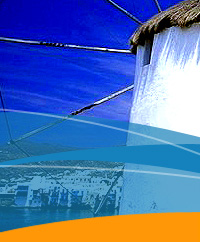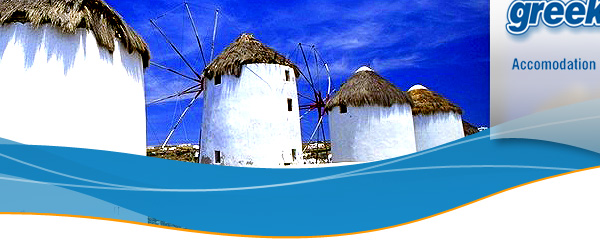|
 |
|
 |
| |
 |
Kos Island |
Information on Kos holidays - Greece |
| |
|
|
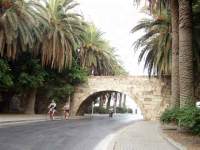 Kos island is not really the best holiday spot for the dedicated solitude seekers since every summer young people from all over Europe invade the island and transform it into a giant nightclub!
So, when you come to Kos island, bring your beach gear and tune in to the bars, discos and a terrific nightlife! Apart from its wild nightlife, Kos is, however, really well worth visiting.
Kos is the island that gave the world Hippocrates, the father of medicine. The third largest island of the Dodecanese, it is a very green island with an excellent infrastructure and large roads lined up with palm trees. During your visit to Kos, you must certainly visit the ancient ruins of the city that are numerous and remarkable, the ruins of 'Asklipios", the 'Castle of the Knights'and the huge tree of Hippocrates (trunk diameter is 11,5 meters!).
On Kos you will find some of the finest beaches in the Dodecanese islands of Greece, many of which can be reached by bicycle! Kos island is not really the best holiday spot for the dedicated solitude seekers since every summer young people from all over Europe invade the island and transform it into a giant nightclub!
So, when you come to Kos island, bring your beach gear and tune in to the bars, discos and a terrific nightlife! Apart from its wild nightlife, Kos is, however, really well worth visiting.
Kos is the island that gave the world Hippocrates, the father of medicine. The third largest island of the Dodecanese, it is a very green island with an excellent infrastructure and large roads lined up with palm trees. During your visit to Kos, you must certainly visit the ancient ruins of the city that are numerous and remarkable, the ruins of 'Asklipios", the 'Castle of the Knights'and the huge tree of Hippocrates (trunk diameter is 11,5 meters!).
On Kos you will find some of the finest beaches in the Dodecanese islands of Greece, many of which can be reached by bicycle!
|
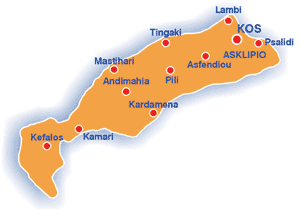 |
|
 |
 |
 |
 |
About Kos island! |
|
 |
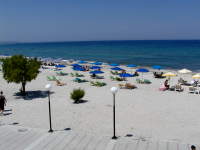 Kos is the third largest island of the Dodecanese archipelago, after Rhodes and Karpathos . It lies between the islands of Nisyros and Kalymnos, close to the coasts of Asia Minor. Kos is the third largest island of the Dodecanese archipelago, after Rhodes and Karpathos . It lies between the islands of Nisyros and Kalymnos, close to the coasts of Asia Minor.
A perfect area for holidays, Kos is the greenest and most fertile island of the group and the second more touristy and popular island after cosmopolitan Rhodes. Kos is the island that gave the world Hippocrates, the father of medicine. It is long and narrow in shape, mostly flat with two low mountains, Dikaio (875 m.) and Simpatro, that run along its southern coast. Kos has so many interesting places to discover that the visitor's needs are almost entirely covered - appealing mountainous villages, excellent touristy infrastructure, verdant landscape, abundant ground water and superb beaches of various sizes and colours. The island of Kos is truly a place to explore. There are beautiful beaches all over Kos - some of them accessible by bicycle a means of transport much used on Kos. The town and capital of Kos is situated to the NE of the island. It is not large but its wide paved avenues, the profusion of greenery, the long alleys of palm trees, the well designed town create a strong impression. With many archaeological sites in and around the town, Kos is the ideal place for walking or cycling. There is agreat variety of modern tourist shops, bars, coffee shops and restaurants. The harbour is undeniably picturesque with many excursion boats, yachts, cutters and traditional fishing boats. For those who want to stay close to town, there are well-appointed public beaches within walking distance to the east and west of Kos, offering many facilities and a great selection of water sports. The island boasts with villages well known for their beauty e.g. ASFENDIOU (14 kms from the city), KARDAMENA (by the sea) and PYLI a village resting on the slopes of Mount Dikeos and looking over a green valley. From Pyli the road leads to Palio Pyli, with remnants of an old castle, and to the fishing villages of Marmari and MASTICHARI. At the southwestern tip of Kos lies KEFALOS, a village endowed with wonderful sandy beaches and little tavernas. Kefalos is built on a hilltop, with white-washed houses, clean roads and splendid beaches. The ruins of the ancient city Astypalia, which was founded in 412 BC and was the ancient capital of the island, can be found in the area known as "Palatia". Another beautiful spot is the small village of ZIA, on the green slopes of Mount Dikeos, with running water and a magnificent view of Kos and of other nearby islands. To the south of Zia lies Tigaki, one of the most beautiful and popular beaches on the island. The village of Antimachia is situated in the centre of the island, only one kilometre from the airport. Kardamena, 25 kms from Kos, is a popular seaside resort, especially in the summer. |
 |
 |
 |
 |
Kos History |
|
 |
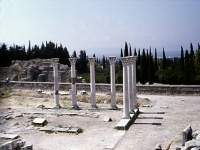 Kos was inhabited in prehistoric times. Around the 14th century BC, arrived in the islands the Minoans from Crete. A few centuries later, the Dorians started to arrive. Around 700 BC they built the ancient city of Kos, which together with Lindus, Cameirus, Ialysos on Rhodes, Cnidus and Halicarnassus in Asia Minor formed the so-called Dorian Hexapolis. In the 5th century BC, Kos was taken by the Persians, but after their defeat in mainland Athenian League (479 BC). In 460 BC, Hippocrates, the Father of Medicine, whose name is known throughout the world, since he was the founder of the first school of medicine, was born in Kos. After his death (357 BC), the people of Kos built the famous Asklepeion, in honour of the god Asklepios, which operated as a hospital, admitting thousands of patients from all over the Mediterranean and applying the methods of therapy taught by Hippocrates. According to mythology, Kos is the sacred land of Asclepius, god of healing. Archaeological finds prove that this island was inhabited since prehistoric times. The Minoan settled on the island around the Kos was inhabited in prehistoric times. Around the 14th century BC, arrived in the islands the Minoans from Crete. A few centuries later, the Dorians started to arrive. Around 700 BC they built the ancient city of Kos, which together with Lindus, Cameirus, Ialysos on Rhodes, Cnidus and Halicarnassus in Asia Minor formed the so-called Dorian Hexapolis. In the 5th century BC, Kos was taken by the Persians, but after their defeat in mainland Athenian League (479 BC). In 460 BC, Hippocrates, the Father of Medicine, whose name is known throughout the world, since he was the founder of the first school of medicine, was born in Kos. After his death (357 BC), the people of Kos built the famous Asklepeion, in honour of the god Asklepios, which operated as a hospital, admitting thousands of patients from all over the Mediterranean and applying the methods of therapy taught by Hippocrates. According to mythology, Kos is the sacred land of Asclepius, god of healing. Archaeological finds prove that this island was inhabited since prehistoric times. The Minoan settled on the island around the
14th century BC, followed by the Achaeans and, a few centuries later, the Dorians came and built the ancient city of Kos. The Persians conquered the island of Kos during the 5th century BC but were defeated by the Athenians (in the battle of Salamina) who took control of the island.
460 BC is the year during which Hippocrates, the father of Medicine (founder of the first School of Medicine), was born.
After his death in 357, the inhabitants of Kos built the Asklepeion in his honour and in honour of the god Asklepios. This served as a hospital, welcoming patients from all over the Mediterranean, with doctors applying the therapeutic methods of Hippocrates. During the Peloponnesian War (431-404 BC), Kos was ally with Athens.
That is why the island had to pay a high tribute when Spartians invaded it in 411 BC. In 394 BC, Kos became again ally with Athens and democracy was introduced on Kos. This period was characterized by a cultural, educational and economical growth. In 335 BC, the island of Kos became part of the Macedonian Empire. After the death of Alexander the Great, the Ptolemies (its successors) took control of the island and of the rest of the Dodecanese. The Byzantine period brought prosperity and wealth to Kos, unfortunately threatened by constant pirate raids of which the most dangerous was the attacks of the Saracens. Kos became part of the Eastern colony of the Roman Empire after 82 BC. In 1204 AD, the Venetians occupied the island of Kos. The Knights of Saint John, who were established on Rhodes, also took the control of Kos in 1315 AD. A century later, they built the superb fortress that stands today at the entrance of the harbour of Kos as well as other fortifications. In 1522, the Turks took the island and held it until 1912, when the Italian troupes invaded Kos and expelled them. The disastrous earthquake of 1934 destroyed almost all the island.
The Germans replaced Italians in 1943. German occupation was a very dark period for the inhabitants of Kos who endured great suffering and deprivations. Nightmare ended in 1945 and Kos came under British rule. Finally, on the 7th of March 1948, Kos was united to the newly built Greek State. |
 |
 |
Kos BEACHES |
|
 |
| In Kefalos you can swim in Kamari, Xrisi Akti, Polemi, Xerokambos, Lagades, Paradisos, Kamila, Aghios Theologos. On Tigaki Beach. In Kardamena, Meropida, Psalidi, Atlandis, Lambi, Faros, Marmari, Mastichari, Thermes, Aghios Fokas. |
 |
 |
Kos island useful information |
|
 |
Area code: +30 22420
Harbourmaster: 26594
Police: 49333
Tourist Police: 26666
Municipality: 28420, 28223
First Aid: 22300 |
 |
 |
Kos Sailing/Yachting information |
|
 |
Mooring is plentiful in Kos.
You can moor your boat in the ports of Kos, Kardamena, Mastichari, Kefalos or Limnioti.
There is a fuel and water refuelling station in the port of Kos. |
 |
 |
Transportation on Kos island |
|
 |
| By bus (very frequent schedules), taxis, rented cars, motorcycles or bicycle. |
 |
 |
Kos Festivals/Feasts |
|
 |
- In August the 'Hippocrateia' with theatrical shows
- In Kefalos the feasts of Aghia Paraskevi - June 26th
- St. John - August 29th
- Assumption of Virgin Mary - August 15th
- St. Demetrios - Oct. 26th
- Aghia Trias-June 4th
- Aghion Apostolon - June 30th
- St. Niketas-Sept. 15th
- Beheading of St. John the
Baptist-August 29th.
|
 |
 |
Kos Excursions |
|
 |
Kos is connected on a daily basis to the nearby Dodecanese island of Nisyros . An island worthwhile visiting for its unique volcanic crater. |
|
 |
 |
Kos SITES/MUSEUMS |
|
 |
Some of the most important sites of Kos worth visiting are the following:
The "Neratzia Castle"
It is situated in the entrance of the Kos harbour on a place where, in antiquity, there was an island, communicating with the inland through a brigde, that one sees even today (The bridge of the Phoenicians' street). It is formed of two defensive precincts. The interior one has four circular Towers in the corners; the southeastern Tower forms part of the exterior precinct, which is larger than the first, with massive bastions on the four corners, battlements and gunports. The two precincts are separated by a large moat and communicate with a drawbridge. The castle was built of local stone as well as parts of ancient buildings (columns, architraves, bases etc.) from the ruins of the ancient city. On the upper part of its masorry, one can see many blazons. Over the main gate' s one sees an hellenistic frieze with masks and garlands. On the gates ceiling (central gate, Carmadino gate) there are basalt columns placed obliquely, which come probably from the early christian basilica of Limen.
The Castle of the Knights This fortress, along with the castles of Rhodes City and Bodrum, was the most stalwart defence of the Knights against the Ottoman. It was first built during the 14th century, and used to have massive outer walls and an inner keep. It was damaged in 1495 by an earthquake and was restored by two Grand Masters of the Knights during the 16th century. This beautiful and impressive castle is standing on Finikon (Avenue Palm), connected to Platanou Square by a bridge, in Kos Town.
The Asckepeion of Kos Situated 4 km west of Kos, Asklepeio is the most significant archaeological site on the island. The excavations here began in 1902, by Iakovos Zaraftis from Kos and Hertsok from Germany. Asklepeio was built in a green area full of cypress trees. During the ancient years, it served as a sanatorium and it was dedicated to Aesculapius, son of Apollo, protector of health and medicine. Many significant people taught and worked here, one of them being the father of Medicine, Hippokrates. Due to the steep ground, Asklepeio consist of four connecting levels, called "andira". The first is characterized by ruins of Roman constructions of the 1st century AD. The second, where the medical school is said to have been housed, is known for its arches and statues. The spas were here and they were watered from the spring of King Halkon and the spring of Vournika on Mount Dikeo. The third level is where the Temple of Aesculapius of Kiparissios Apollo (4th century BC) used to be. Excavations in the surrounding area brought to light an invaluable treasury for visitor's offerings, a semi-circular platform and a small Roman temple dedicated to Neron. The fourth level was constructed in the 2nd century BC and included a large temple of Doric style along with the chambers of the patients.
- Hippocrates Plane tree
- "Kamara tou Forou"
- The archaeological museum
|
|
|
| |
| |
|
| |
| [back to top] |
|
 |
|
 |
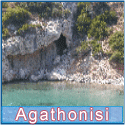 |
 |
| |
 |
| |
| |
| ::: How to get to Kos island information |

|
 |
 |
Airplane schedules:
There are 3 to 4 daily flight to Kos from Athens in the summer and 1 to 2 in the winter.
Flight time from Athens is approximately 1 hour.
Flights leave from Athen's Eleftherios Venizelos Airport.
For more information and up-to-date timetables contact:
Olympic Airways
Reservations:
+30 210 966-6666
Aegean Airlines
Reservations:
+30 8011120000
|
| |
| ::: Ferry Boat and hydrofoil information for Kos: |
 |
 |
 |
There are 10 weekly scheduled departures from Piraeus to Kos in the summer, and 6 in the winter.
Travel time from Piraeus is approximately 15 hours.
More information and scedules on Kos ferry boats and hydrofoils:
Greek Travel Pages
Piraeus Port Authority
Tel: +30 210 4226000
Rhodes Port Authority
Tel: +30 22410 28888/22410 22220 |
| |
| ::: Ferry boat connections from Kos to other islands: |
 |
 |
 |
Dodecanese Islands:
Agathonissi, Astypalea, Chalki, Kalimnos, Kastelorizo, Leros, Lipsi, Nisyros, Patmos, Rhodos, Symi, Tilos
Cyclades Islands:
Amorgos, Mykonos, Syros
Other Ports:
Alexandroupolis (Northern Greece), Chios, Lesvos, Samos (North Aegean island)
|
| |
 |
 |
 |
|



